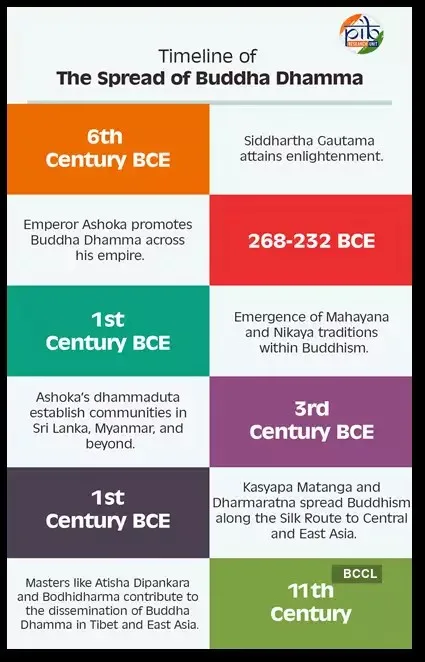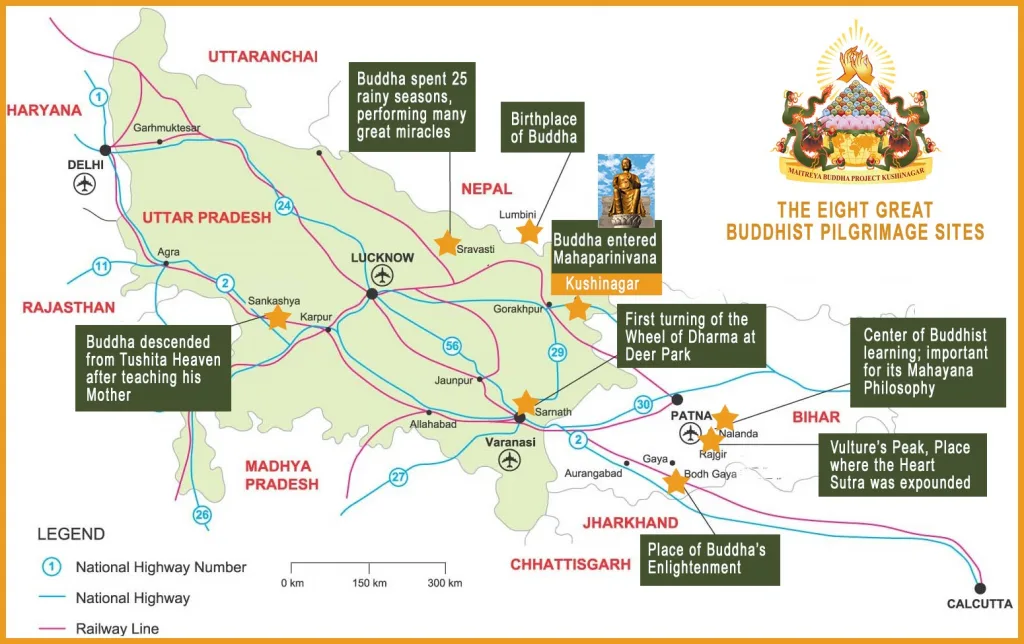Syllabus: GS1/Culture/GS2/IR
Context
- The Ministry of Culture, in collaboration with the International Buddhist Confederation (IBC) organized the First Asian Buddhist Summit (ABS).
About
- The theme of the summit is on ‘Role of Buddha Dhamma in Strengthening Asia’.
- The summit brought Sangha leaders, scholars, experts and practitioners from various Buddhist traditions across Asia.
- Asian Buddhist Summit covered the following themes:
- Buddhist Art, Architecture and Heritage;
- Buddha Cārikā and Dissemination of Buddha Dhamma;
- Role of Holy Buddhist Relics and its Relevance in Society;
- Significance of Buddha Dhamma in Scientific Research and Well-Being;
- Role of Buddhist Literature and Philosophy in the 21st Century.
- The Summit is also a manifestation of India’s Act East Policy, which is principled on collective, inclusive and spiritual development of Asia with Dhamma as the guiding light.

Buddhism
- Buddhism is a spiritual and philosophical tradition based on the teachings of Siddhartha Gautama, known as the Buddha, who lived around the 5th to 4th century BCE in what is now Nepal and India.
- The core of Buddhism is the understanding of human suffering, its causes, and the path to overcome it.
- Buddhism offers a path to enlightenment, which is seen as liberation from suffering and the cycle of birth, death, and rebirth (samsara).
- The ultimate goal in Buddhism is to attain Nirvana—a state of liberation from the cycle of birth, death, and rebirth.
Relevance of Buddhist Teachings in Today’s World
- Mindfulness and Meditation: In recent decades, mindfulness meditation, a central Buddhist practice, has become widely embraced for its mental health benefits.
- Emotional Resilience: Buddhism teaches the importance of accepting suffering as a part of life (dukkha), this can help people build resilience in the face of adversity.
- Peace and Nonviolence: Buddhism advocates for nonviolence (ahimsa) and peaceful resolution of conflicts, offering a model for dialogue and reconciliation.
- Forgiveness: Buddhist principles also emphasize the importance of forgiveness, his teaching is particularly relevant in post-conflict societies or communities dealing with historical trauma.
- Transcending Materialism: In a world often fixated on material wealth, Buddhism provides an alternative perspective on happiness—rooted in inner peace, wisdom, and compassion.
Soft Power Diplomacy
- Soft Power: The concept of soft power has emerged as a potent tool for countries to wield influence and shape perceptions without resorting to coercive tactics.
- This is often referred to as soft hegemony, a concept used by western countries, especially the United States.
- It is used to influence other cultures by subtly promoting their ideas and values through popular trends, particularly targeting the younger generation.
- Joseph Nye was the first to coin the term “soft power”.
Buddhism as India’s Cultural Soft Power Diplomacy
- To Strengthen Ties with South Asian Countries: Many Southeast Asian nations, such as Thailand, Myanmar, Cambodia, Laos, Vietnam, and Sri Lanka, have deeply rooted Buddhist traditions.
- India has been strategically leveraging its rich Buddhist heritage to strengthen ties and counter China’s growing influence.
- Positioning Itself as a Peaceful Nation: By emphasising shared values and diversity, India aims to not only deepen diplomatic and economic relations but also position itself as a beacon of peace and stability in the region.
- Origin of Buddhism: India’s promotion of Buddhist diplomacy is bolstered by historical roots, with Buddhism originating there, and the presence of significant sites like Bodh Gaya.
- The Dalai Lama and India’s Global Influence: Living in exile in India since 1959, the Dalai Lama serves as an ambassador of Buddhist philosophy.
- India’s support for the Dalai Lama and Tibetan Buddhism has increased its influence among Buddhist communities worldwide.
- The Revival of Nalanda University: The original Nalanda University, established in the 5th century CE, was a major center for Buddhist studies, attracting students and scholars from all over Asia.
- The new Nalanda University aims to be a global hub for education and research in Buddhist studies.
- Buddhist Art and Monuments: Indian Buddhist art and architecture, such as the Ajanta and Ellora Caves, the Sanchi Stupa, and the Great Stupa at Sarnath, are UNESCO World Heritage sites that serve as symbols of India’s cultural heritage.
- Foreign Policy: The country’s foreign policy emphasises a non-military approach, including the Panchsheel Initiative and the Panchamrit Principles.
- One crucial aspect is Sanskriti evam Sabhyata, highlighting India’s cultural connections with other nations to bolster its soft power strategy.
- Tourism: India is currently home to seven of the eight most significant Buddhist sites in the world.
- The Ministry of Tourism is promoting a number of tourist circuits that transgress national borders.
- The holy places of Buddhism, where Lord Buddha was born and He taught, preached, and attained ‘Enlightenment’ and ‘Nirvana’, are termed as Buddhist Circuit.
- The Ministry of Tourism is promoting a number of tourist circuits that transgress national borders.

Conclusion
- The historical intertwining of Indian and Asian cultures through Buddhism provides a strong foundation for fostering mutual understanding and cooperation.
- By leveraging historical, cultural, and religious ties, India seeks to foster mutual understanding, cooperation, and goodwill among nations.
- Through initiatives such as the promotion of Buddhist tourism and the revival of Nalanda University, India endeavours to assert its leadership in the realm of academia while simultaneously strengthening its cultural and diplomatic foothold.
Source: PIB
Previous article
News In Short 05-11-2024
Next article
Every Private Property Not a Community Resource: SC